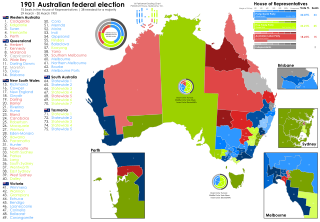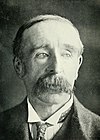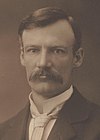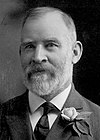
Sir George Houston Reid was an Australian politician, diplomat and barrister who served as the fourth prime minister of Australia, from 1904 to 1905, holding office as the leader of the Free Trade Party. He previously served as the 12th premier of New South Wales from 1894 to 1899, and later the High Commissioner to the United Kingdom of Australia from 1910 to 1916.
The Free Trade Party, officially known as the Australian Free Trade and Liberal Association, also referred to as the Revenue Tariff Party in some states, was an Australian political party, formally organised in 1887 in New South Wales, in time for the 1887 colony election, which the party won. It advocated the abolition of protectionism, especially protective tariffs and other restrictions on trade, arguing that this would create greater prosperity for all. However, many members also advocated use of minimal tariffs for government revenue purposes only. Its most prominent leader was George Reid, who led the Reid government as the fourth Prime Minister of Australia (1904–05). In New South Wales it was succeeded by the Liberal and Reform Association in 1902, and federally by the Anti-Socialist Party in 1906. In 1909, the Anti-Socialist Party merged with the Protectionist Party to form the Commonwealth Liberal Party.
The Protectionist Party, also known as the Protectionist Liberal Party or Liberal Protectionist Party, was an Australian political party, formally organised from 1887 until 1909, with policies centred on protectionism. The party advocated protective tariffs, arguing it would allow Australian industry to grow and provide employment. It had its greatest strength in Victoria and in the rural areas of New South Wales. Its most prominent leaders were Sir Edmund Barton and Alfred Deakin, who were the first and second prime ministers of Australia.
This is a list of the members of the Australian House of Representatives in the First Australian Parliament, which was elected on 29 and 30 March 1901. There were 75 members, as required by the Constitution, as near as possible to twice the number of Senators which was then 36. South Australia and Tasmania had not been divided into electoral divisions in 1901 which resulted in the particular state voting as a single electorate. There were seven members for South Australia, and five members for Tasmania elected.

Alexander Poynton OBE was an Australian politician. He held ministerial office under Prime Minister Billy Hughes, serving as Treasurer (1916–1917), Minister for Home and Territories (1920–1921), and Postmaster-General (1921–1923).

Donald Norman Cameron was an Australian politician. He served in the House of Representatives and Tasmanian House of Assembly.

The 1901 Australian federal election for the inaugural Parliament of Australia was held in Australia on Friday 29 March and Saturday 30 March 1901. The elections followed Federation and the establishment of the Commonwealth of Australia on 1 January 1901. All 75 seats in the Australian House of Representatives, six of which were uncontested, as well as all 36 seats in the Australian Senate, were up for election.

The 1903 Australian federal election was held in Australia on 16 December 1903. All 75 seats in the House of Representatives, and 19 of the 36 seats in the Senate were up for election. The incumbent Protectionist Party minority government led by Prime Minister Alfred Deakin retained the most House of Representatives seats of the three parties and retained government with the parliamentary support of the Labour Party led by Chris Watson. The Free Trade Party led by George Reid remained in opposition.

The 1906 Australian federal election was held in Australia on 12 December 1906. All 75 seats in the House of Representatives, and 18 of the 36 seats in the Senate were up for election. The incumbent Protectionist Party minority government led by Prime Minister Alfred Deakin retained government, despite winning the fewest House of Representatives votes and seats of the three parties. Parliamentary support was provided by the Labour Party led by Chris Watson, while the Anti-Socialist Party, led by George Reid, remained in opposition.

The 1909 Tasmanian state election was held on Friday, 30 April 1909 in the Australian state of Tasmania to elect 30 members of the Tasmanian House of Assembly. This was the first general election in the British Empire to elect all members through a form of proportional representation, the single transferable vote.
The Division of Tasmania was an Australian electoral division covering Tasmania. The five-member statewide seat existed from the inaugural 1901 election until the 1903 election. Each elector cast one vote. Unlike most of the other states, Tasmania had not been split into individual single-member electorates. The other exception was the seven-member Division of South Australia. The statewide seats were abolished at a redistribution conducted two months prior to the 1903 election and were subsequently replaced with single-member divisions, one per displaced member, with each elector now casting a single vote.
This article provides information on candidates who stood for the 1901 Australian federal election. The election was held on 29/30 March 1901.
This article provides information on candidates who stood for the 1903 Australian federal election. The election was held on 16 December 1903.
This is a list of members of the Australian Senate from 1907 to 1910. Half of its members were elected at the 16 December 1903 election and had terms starting on 1 January 1904 and finishing on 30 June 1910; the other half were elected at the 12 December 1906 election and had terms starting on 1 January 1907 and finishing on 30 June 1913. They had an extended term as a result of the 1906 referendum, which changed Senate terms to finish on 30 June, rather than 31 December.
The following tables show state-by-state results in the Australian Senate at the 1901 federal election. Senators total 17 Free Trade, 11 Protectionist, and eight Labour. The terms were deemed to start on 1 January 1901. In each state, the first three elected received full six-year terms, and the three senators elected with the lowest number of votes retire after three years.

Chanter v Blackwood and the related case of Maloney v McEacharn were a series of decisions of the High Court of Australia, sitting as the Court of Disputed Returns arising from the 1903 federal election for the seats of Riverina and Melbourne in the House of Representatives. Chanter v Blackwood , and Maloney v McEacharn , determined questions of law as to the validity of certain votes. In Chanter v Blackwood Griffith CJ held that 91 votes were invalid and because this exceeded the majority, the election was void, while Chanter v Blackwood dealt with questions of costs. In Maloney v McEacharn more than 300 votes were found to be invalid and the parties agreed it was appropriate for the election to be declared void.
This is a list of electoral division results for the Australian 1901 federal election.
The Australian states each elected three members of the Australian Senate at the 1903 federal election to serve a six-year term starting on 1 January 1904.
The Australian states each elected three members of the Australian Senate at the 1910 federal election to serve a six-year term starting on 1 July 1910.
This is a list of electoral results for the Australian Senate in Victoria since Federation in 1901.














